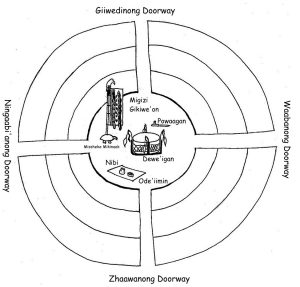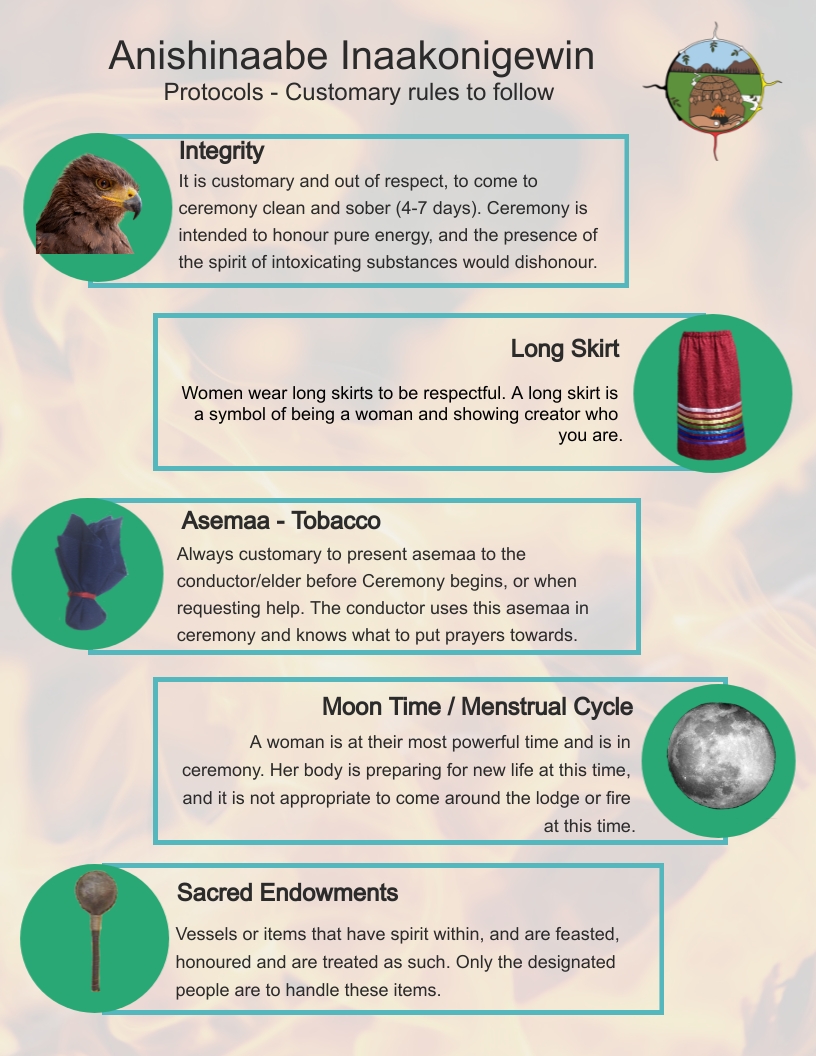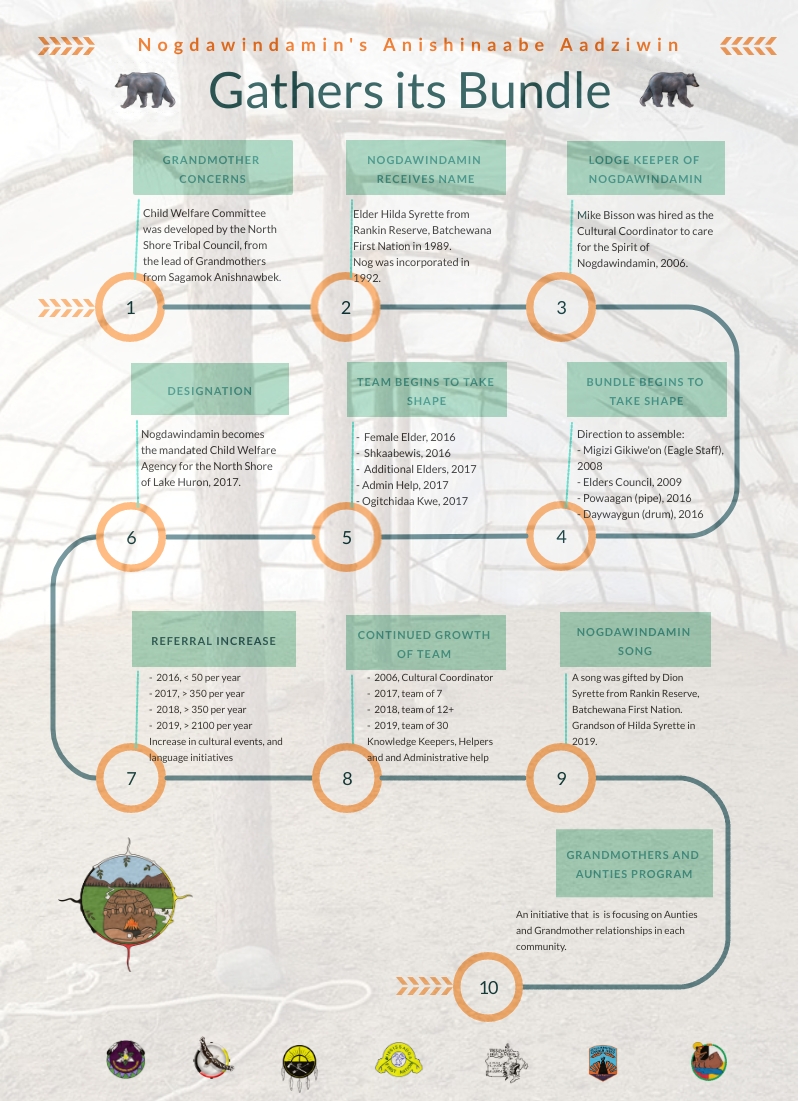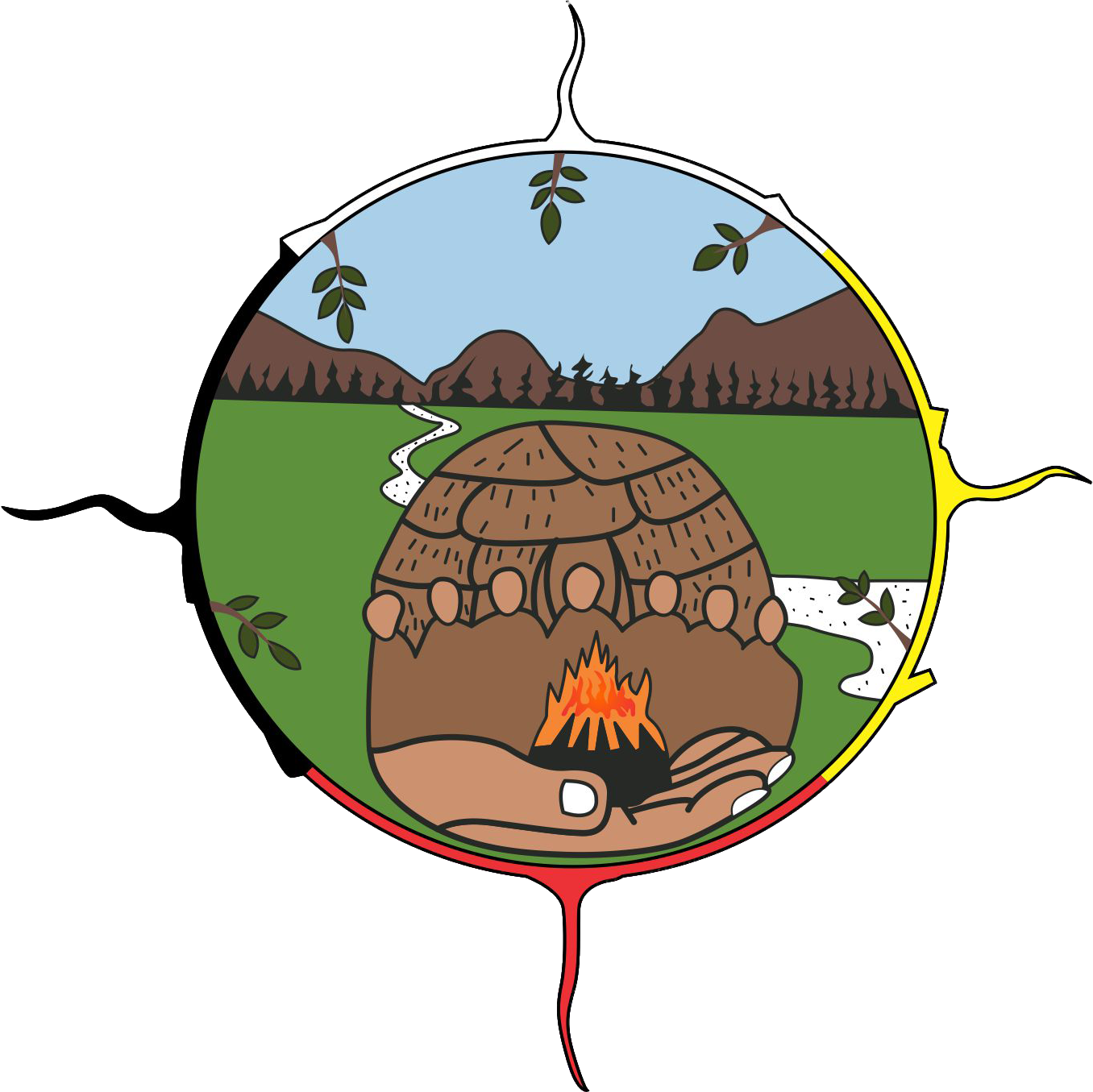1
Learning Objectives
To introduce spirit, which is the fundamental concept of Anishinaabe Culture. This session will expand to the introduction to the Spirit of Nogdawindamin and to explain that we are all apart of that Lodge.
Foundations in Life:
- Understanding the meaning of a Traditional Opening;
- Understanding the importance of cultural Protocols;
- Introduction to the Spirit of Nogdawindamin, and understanding your place within it; and
- Getting to know the Anishinaabe Aadziwin Team, (Cultural Services Team).
A Traditional Opening
Indigenous people always begin with a traditional opening, which brings our hearts and minds together with a clear and focus intention. At his time Spirit is acknowledged, thanked and invited into the assembly. There is a set of protocols that are followed and may be different from nation to nation.

The traditional opening mirrors Nogdawindamin’s Seasonal Staff Ceremonies. See diagram 1:1
The room set up consists of a space in the center for Nogdawindamin’s bundle and sacred endowments:
- Pipe
- Grandfather Drum with chairs
- Eagle Staff
- Blanket for Copper vessel, wooden bowl with feast foods, wooden bowls for medicines.
These endowments ALWAYS belong in the center of the assembly, these are apart of the heart of Nogdawindamin.
The center space is surrounded by a circle chairs, ensuring to leave space open in the four directional doorways. Depending on the number of people, multiple rows of chairs may need to be added.
Order of Ceremony:
- Lighting of the Fire; customary to but tobacco in fire before beginning.
- Smudge space and people.
- Lighting of the Pipe.
- Eagle Whistle to call in spirits and get creator’s attention.
- Drum Call, a strike for each direction.
- Pipe song, played while pipe is being smoked.
- Tobacco offered to the people for prayer.
- Opening song, calling in and welcoming the ancestors.
- Prayer, acknowledging Treaty Territory.
- Prayer for Water & Berries, and pass out to the people.
- Tobacco to be gathered and placed into fire.
Facilitator Tip:
For the purpose of training, it is recommended to have a single layer of chairs in circle.
If the location of traditional opening is in a Teaching Lodge, lighting of the fire is the first act and apart of the protocol of opening ceremonies.
Grandmother’s Prayer
- Female Knowledge Keeper (Ehkinoomaagejig), Role and Responsibility
- Practices and lives this way of life
- Holds space for families to do healing work
- Bring back Cultural knowledge and teachings to communities
- Promoting Mino – maadiziwin, the “good life”
- Ogitchidaa Kwe, Role and Responsibility
- Apprentice, learning from Knowledge Keepers
- Arrive before and leaves after everyone, cleanse the space (prepare/setup)
- Female role to look after water, berries gathering cedar
- Bring medicines to gatherings
- Prayer: a sacred time for centeredness and connection. It is a time to go inward and to address Gitchi Manito the Great Mystery. This is a time to pray in your own way.
- Collective: praying together brings the collective consciousness as one.
- Acknowledgement to the traditional caretakers of the land. We are in the Robinson Huron Treaty of 1850.
Indigenous on Treaties – Ministry of Indian Affairs Website
- The Sacred Circle: The sacred circle is a symbol of wholeness and cycles. We are taught this from the Creation Story with the formation of the Sun, Moon and Earth. This is recreated in ceremonies with the motion of clockwise direction.
- The Four doorways (Wayn-da-ni-muk’ no-di-noon’) are known as the four directions, acknowledging each is important for harmony of the circle.
- Waabanong – Eastern
- Zhaawanong – Southern
- Ningaabii’anong – Western
- Giiwedinong – Northern
- Ceremony is bringing attention of the collective to focus on an intended purpose and acknowledging our ancestors and Gitchi Manito. In an opening, there is protocol to honour integrity of the spirit and an order to follow. The men’s role and responsibility is to speak about the Fire, Pipe and the Drum; and the Women’s roles and responsibility is to look after the water and the berries.
Protocols – Anishinaabe Inaakonigewin, Natural Law
- Moon Teachings, A woman is at their most powerful during their cleansing menstrual cycle, and it is not appropriate to come around ceremony or sacred items such as the pipe, drum and fire at this time. A women’s body is preparing for new life, and they are close to the doorways of life entering and leaving this realm. The influence of a women energy at this time overpowers sacred endowments.
- Moon Lodge, is a space that is prepared with the protection medicine of cedar. If you are on your time at ceremony, this is where you can sit and still listen. Helpers will assist with getting Moon Lodge and the Women food. Women are asked if they choose to be attend that they not leave the moon lodge.
- Skirts, women wear long skirts to be respectful. A long skirt is a symbol of being a woman and showing creator who you are.
- The word Integrity is to explain that it is customary and out of respect to come to ceremony clean and sober (4-7 days). Ceremony is intended to honour pure energy, and the presence of the Spirit of intoxicating substances would dishonour. This also includes negative attitudes and behaviours.
- A blanket (Waabooyaan) is for the water, feast foods any another item of importance. Give Away items would also be laid out on a blanket, and not straight on the floor. At the Bear Feast, people are invited to bring their Sacred Endowments and place on blanket to be honoured and feasted.
- Water (Nibi) is a natural element that is honoured at every ceremony. Nibi are the tears of creator that came to our Mother Earth for her beauty and became her lifeblood. Every organism on Earth needs clean water to survive. Acknowledging and thanking the water is in every ceremony the Anishinabek people practice. This is done by holding the water up and singing to it in each direction.
-
- Anishinaabemowin historian, James Vukelich shared that the word Nibi is a ancient word to Anishinaabe people and was used prior to the ice age, and the formation of the Great Lakes.
-
Nibi Song by Doreen Day and Mashkoonce
| Ne-be Gee Zah- gay- e- goo Gee Me-gwetch -wayn ne- me – goo Gee Zah Wayn ne- me- goo |
Water, we love you. We thank you. We respect you. |
For the story of the Nibi Song, visit this link to the Mother Earth Water Walk website.
Mother Earth Water Walkers Website
- Copper Vessel (Miskwaabik) is an ancient and natural mental that was found on the rocks in Northern Ontario and sacred to Anishinaabe Peoples. They knew it has distinct and powerful conductive properties. It is believed that copper vessels clean, heal and amplify our prayers. [1]
- People bring small copper cups in their bundles to receive the purified water to drink in ceremony. Taking water in bare hand is also practiced.
- Strawberries (Ode’iimin ) are the head of all the berries, the translation means heart berry. As teachings come from observing creation, the strawberry is a good example. This plant grows as an intricate vein system (runners, roots, leaves) under the soil. As do our hearts and veins under our skin and have a connection with our whole body. The body and mind treated together.
- It is the first berry in spring after the winter and thaw. It symbolizes the relationships in our lives and is acknowledged and thanked in every ceremony the Anishinabek people practice.
- Wooden Bowls or material from natural world used to hold the berries and feast foods to honour the integrity of the natural energies.
- Feast Plate is a small bowl made from natural materials like birch bark. A small bite of all the food, is gathered in the bowl and is offered to the Ancestors by fire or put out in the natural environment.
- Feast Bundle is a collection of your personal reusable plate, bowl, cutlery and cup and kept in a reusable bag. Helping to protect Mother Earth and not needing to continue to use “disposable” plates made from Styrofoam. We use these at feasts and gatherings.
Nogdawindamin’s Birth Story

In the 1980’s, there were nookomisag (grandmothers) from Sagamok Anishnawbek were not able to have a relationship with their noozhisag (grandchildren) because they were brought into care by the mainstream CAS. They had brought their concerns to their Ogemaa (Chief). Sagamok Anishnawbek Chief brought the concerns to the North Shore Tribal Council and was the catalyst to the formation of a Child Welfare Committee; their top priorities were:
- Language & Culture
- Less intrusiveness
- Healing
In 1989, another Nookomis Hilda Syrette from Rankin Reserve of the Batchewana First nation gifted the name Nogdawindamin. This name broken down is translated to mean Nog – the center of thoughts, windamin – taking care of state of mind/well being. We know this as Protecting our children’s state of mind and well being.
Mike Bisson was asked to join and to take care of the Spirit of Nogdawindamin in 2006, and he started to gather Nogdawindamin’s Bundle and the Elders Council. The Elders Council are representatives that were chosen from within each of the 7 First Nations. This council was intended to be a source of guidance and direction.
{Insert Mike Bisson Origins Clip}
Nogdawindamin’s Bundle
Facilitator Tip:
Give an in-depth explanation of:
- Fire Teachings
- Eagle Teachings
- Tobacco Teachings
- Fire (Ishkode), is the heart of any ceremony. It is accompanied with its caretaker the Shkawbewis, and Mashkiki (medicines) for prayers and offerings. The Feast foods and offerings are made throughout the ceremony. It is customary to visit the fire before going into the lodge to clean oneself off, of impurities.
- Male Knowledge Keeper (Ehkinoomaagejig), roles and responsibilities
- Practices and lives this way of life
- Holds space for families to do healing work
- Bring back Cultural knowledge and teachings to communities
- Promoting Mino – maadiziwin, the “good life”
- Shkaabewis, roles and responsibilities
- Apprentice, learning from Knowledge Keepers
- Arrive before and leaves after everyone, cleanse the space (prepare/setup)
- Male role to look after fire and everything that is involved
- Build lodges and erect Tipi’s
- Sacred Endowments: Items that have been activated through ceremony and believed to have a spirit within it and considered to be living entities. These endowments are apart of a bundle that is a collective of spirits, they are looked after with love and care.
- These items are treated with special care, respect and attention as if they are a Grandparent. “They are dressed, fed, given a nice bed, talked to, and brought places to visit.” Jim Dumont]
- These items are to be honoured in the centre of the meeting space. They are used in ceremony to call for the ancestors when asking for guidance and direction.
- Eagle Staff (Migizi Gikiwe’on), the immature Eagle is the head Shkaabewis and represents the messenger that takes prayers to Gitchi Manito, the Great Mystery (aka Creator). The Immature eagle represents that we are still young and learning. There are many different types of Eagle staffs for different purposes. Nogdawindamin’s Eagle Staff was brought together to honour the Seven First Nations along the North Shore.
- Eagle Head, honours the spirit of the eagle that watches over us and the direction where we are going.
- 7 Megis Shells represent the 7 First Nations within the Lodge of Nogdawindamin:
- Atikameksheng Anishnawbek
- Sagamok Anishnawbek
- Serpent River First Nation
- Thessalon First Nation
- Garden River First Nation
- Batchewana First Nation
- Mississauga First Nation
-
- Feathers
- 7 Mature Bald Eagle Feathers represent the Elders
- 7 Immature Bald Eagle Feathers represent the Youth
- Turtle Stand, is a symbol of the name of the Drum, and for Turtle Island that supports us.
- Snapping Turtle (Missheke Mikinaak)
- Ribbon represent colours, that represented the colours of the day.
- Biidaabin , First Light – Light Blue
- Waaban, Dawn – Yellow
- Gizhebaagook, Morning – Orange
- Giizhigat, Daytime – Red
- Ehbangishmok, Setting Sun – Purple
- Zhkwabingishmok, Dusk – Dark Blue
- Feathers
- Pipe (Powaagan) a pipe carrier looks after the pipe and keeps the Eagle Staff, Pipe and Drum together. The pipe is smoked before the drum is sounded, to prepare for ceremony. The pipe and prayers are requesting the help of the ancestors.
- At Pipe Gatherings, pipe carriers sit in a circle with their bundles laid out before them. Wooden bowls are used to collect asemaa (tobacco) to be smoked in the pipe to send prayers to creator.
- Tobacco it is always customary to present asemaa to the conductor/elder before Ceremony begins, or when requesting help. The conductor uses this asemaa in ceremony and knows what to put prayers towards.
- Eagle Whistle, A whistle is called four times to honour each direction. When the Eagle whistle is blown, it calls to the attention of Gitchi Manito and that the ceremony is beginning.
- Grandfather Drum (Dewe’igan), when the sound of the drum is made everything stops, so the manidoo (spirits) can be called in and the ceremony can begin.
- Dewe’igan translated means “living heart”. It mimic’s the sound that we hear the first 9 months of our existence on earth, in the womb. There are different types of drums, Nogdawindamin has a grandfather drum and is dressed in a shirt. Men sit around the drum and the Women support by standing around the men. It is the heart, and we all gather around.
- Nogdawindamin’s Drum Name is Missheke Mikinaak, the Snapping Turtle
- Nogdawindamin was gifted a song by Grandmother Hilda Syrette’s grandson, Dion Syrette.
- There is no need to stand when the drum is sounded. It will be announced when to stand and remove hats for an honour song.
- Offerings are items that are offered to the fire; this could be cloth, medicines, food, water, hair or what ever needs to go back to the spirit world.
Designation of Nogdawindamin
Nogdawindamin Family and Community Services was officially designated April 1, 2017.
{Insert Designation Journey Video}
Key Takeaways
- It is fundamental to include Spirit in everything that we do.
- Protocols differ from nation to nation; it is respectful to learn the protocols in the region you are in.
- Nogdawindamin’s Birth Story, its purpose and intention.
- Who the helpers are within Cultural Services.
- Culturally Safe Practices vs Culturally Unsafe Practices.
- Asemaa (tobacco) is more then symbolism, intention of what is being requested is transferred through this medicine.
Media Attributions
- Traditional Opening
- Nog-Gathers-its-Bundle
- Nog_colour High Res
- greatlakeswaterwalk.ca ↵